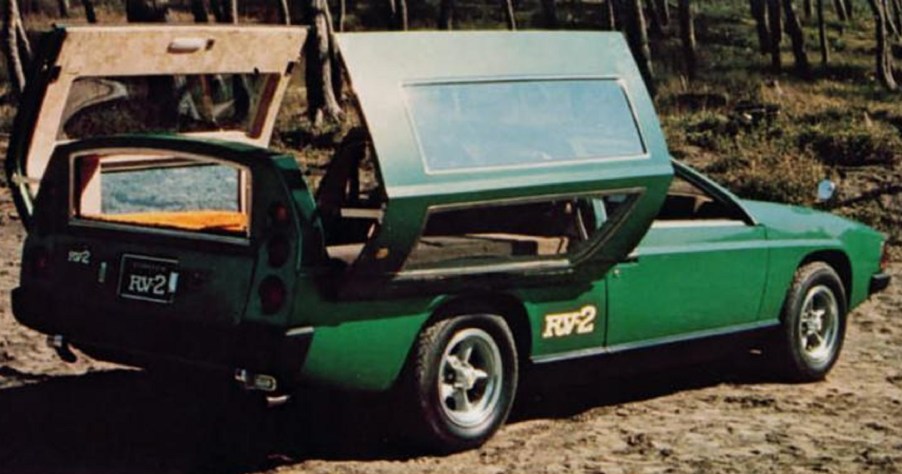
Toyota RV-2: A Forgotten ’70s Camper Van With Wagon Grooves
If you got some strong throwback vibes at Toyota’s 2021 SEMA stand, don’t worry, you’re not alone. Parked among the modified trucks was a tricked-out Toyota Tacoma tribute to the 1970s Chinook camper. However, while the Chinook’s success previewed the popularity of today’s Toyota truck camper builds, it wasn’t the automaker’s first RV attempt. That would be the Toyota RV-2.
Toyota tried tackling camper vans in 1970s style with the RV-1 and RV-2 concepts

Wagons are clinging to life these days in the US, but they were extremely popular in the 1970s. Remember, at this point, the term ‘SUV’ didn’t really exist, and neither did minivans. Back then, wagons like the Volvo 1800ES and Vista Cruiser were practical family cars. And much like today’s crossovers, that meant families used them for vacationing purposes.
However, instead of having to tow an Airstream trailer behind their wagons, vacationers could get purpose-built camper vans instead. Besides the iconic VW Bus and Vanagon, European customers had options like the Bedford Dormobile. And if US campers didn’t want a VW Bus, they could get a Chevrolet Corvair Greenbrier.
At the time, Toyota, like the other Japanese OEMs, was taking cues from Western markets, especially the US one, Top Gear explains. For example, the original 1970 Toyota Celica was the automaker’s take on the contemporary Mustang. And seeing how popular stations wagons and RVs were, Toyota decided to smash both segments together into one vehicle.
That vehicle was the 1971 Toyota RV-1 (‘Recreational Vehicle 1’) concept. Based on the contemporary Celica coupe, the RV-1 has a longer roofline, larger rear storage area, seating for four, and a different rear end. But while it debuted alongside the Celica liftback, the RV-1 doesn’t have a liftgate. However, it doesn’t just have a conventional trunk lid. The Toyota camper concept’s rear window panels are hinged gullwing-style, not unlike a Tesla Model X’s doors.
Technically, the Toyota RV-1 isn’t a camper. While it has plenty of storage space, there’s no sleeping area. Instead, the RV-1 was designed to tow a special hard-shell trailer called the Marinetta, which came with an inflatable tent and air compressor and functioned as a boat. The RV-1’s sequel, the 1972 Toyota RV-2, though, was the real deal.
It wasn’t practical, but the Toyota RV-2 was a functional camper van—er, wagon

Although the Toyota RV-2 is styled after station wagons, its two-door design technically makes it a shooting brake. The RV-1 is, too, to be fair. However, while the RV-1 was more of a tow vehicle than an RV, Toyota made the RV-2 into a real camper—kind of.
Based on the contemporary Corona, aka the Mk II, the Toyota RV-2 has the same stretched roofline and rear space as RV-1. However, it doesn’t have seats in the back. That’s where the master bed/seating area is, complete with removable side benches, Autoevolution says. The rear gate also had a built-in upholstered mini bench. And contemporary marketing materials suggested that the Toyota RV-2 would offer an interior fold-up table in the rear for meals.

At first glance, given the Toyota RV-2’s roofline, that option seems pointless. But it’s not, because the camper’s rear section is basically two clamshell panels. So, while it doesn’t have gullwing windows, the RV-2 does (kind of) have gullwing side panels. That means the occupants can enjoy some fresh air while they snack. And when it’s time to go to sleep, Toyota offered an attachable pop-up tent canopy.
Speaking of sleep, the Toyota RV-2 has sleeping space for four. Two adults can fit in the rear while the front seats fold flat to make impromptu beds. However, this Toyota camper doesn’t have an onboard bathroom or kitchen. It does, though, have a five-speed manual transmission and a 130-hp 2.6-liter inline-six.
What happened to it?
Unfortunately for the sleek Toyota RV-2 camper, it debuted right before an international fuel crisis. Together with the slow decline in station wagon sales, it spelled the end for potential production plans. But even if that hadn’t happened, the RV-2 isn’t particularly practical for a camper. It likely would’ve struggled to sell even in the best circumstances.
So, while there are many Toyota minivan, SUV, and truck camper builds, you won’t find any Toyota wagon builds. However, if someone can make a camping-worthy Porsche 924, someone might be able to make a viable RV-2 tribute. Maybe they’ll even bring it to SEMA.
Follow more updates from MotorBiscuit on our Facebook page.


